Havana, Cuba 作者: 来源: 发布时间:2021-03-23
1.Population and Area
Havana is the capital city, largest city, province, major port, and leading commercial center of Cuba. The city has a population of 2.1 million inhabitants, and it spans a total of 781.58 km2 (301.77 sq mi).
Location:Havana lies on the northern coast of Cuba, south of the Florida Keys, where the Gulf of Mexico joins the Atlantic Ocean.
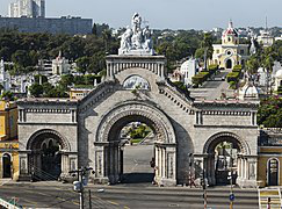
2. Geography
The city extends mostly westward and southward from the bay, which is entered through a narrow inlet and which divides into three main harbours: Marimelena, Guanabacoa, and Atarés. The sluggish Almendares River traverses the city from south to north, entering the Straits of Florida a few miles west of the bay.
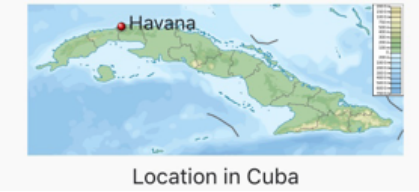
There are low hills on which the city lies rise gently from the deep blue waters of the straits. A noteworthy elevation is the 200-foot-high (60-metre) limestone ridge that slopes up from the east and culminates in the heights of La Cabaña and El Morro, the sites of colonial fortifications overlooking the eastern bay. Another notable rise is the hill to the west that is occupied by the University of Havana and the Prince's Castle. Outside the city, higher hills
rise on the west and east.
Transport:
Urban buses
The city's public buses is carried out by the Empresa Provincial de Transporte de La Habana (EPTH).
Metrobus
The Red Principal, previously known as MetroBus, serves the inner-city urban area, with a maximum distance of 20 km (12 mi).The Red Principal consists of 17 main lines, identified with the letter "P" with long-distance routes. The stops are usually 800–1,000 metres (2,600–3,300 ft), with frequent buses in peak hours, about every 10 minutes. It uses large modern articulated buses, such as the Chinese-made Yutong brand, Russian-made Liaz, or MAZ of Belarus.
Red Alimentadora
The Red Alimentadora, known as the feeder line, connects the adjacent towns and cities in the metropolitan area with the city center, with a maximum distance of 40 km (25 mi).This division has one of the most used and largest urban bus fleets in the country, its fleet is made up of mostly new Chinese Yutong buses.In 2008 the Cuban government invested millions of dollars for the acquisition of 1,500 new Yutong urban buses.
Airports
Havana is served by José Martí International Airport. The Airport lies about 11 kilometres (7 mi) south of the city center, in the municipality of Boyeros, and is the main hub for the country's flag carrier Cubana de Aviación. The airport is Cuba's main international and domestic gateway, it connects Havana with the rest of the Caribbean, North, Central and South America, Europe and one destination in Africa.
The city is also served by Playa Baracoa Airport which is small airport to the west of city used for some domestic flights, primarily Aerogaviota.
Rail
Havana has a network of suburban, interurban and long-distance rail lines. The railways are nationalised and run by the FFCC (Ferrocarriles de Cuba – Railways of Cuba). The FFCC connects Havana with all the provinces of Cuba. The main railway stations are: Central Rail Station, La Coubre Rail Station, Casablanca Station, and Estación de Tulipán.
In 2004 the annual passenger volume was some 11 million,but demand is estimated at two-and-a-half to three times this value, with the busiest route being between Havana and Santiago de Cuba, some 836 kilometres (519 mi) apart by rail. In 2000 the Union de Ferrocarriles de Cuba bought French first class airconditioned coaches.
Interurban (tram)
An interurban line, known as the Hershey Electric Railway, built in 1917 runs from Casablanca (across the harbor from Old Havana) to Hershey and on to Matanzas.
Ferry
Ferries connect Old Havana with Regla and Casablanca, leaving every 10–15 minutes from Muelle Luz (at the foot of Santa Clara Street). The fare is CUP 0.20¢.
Districts:
Contemporary Havana can essentially be described as three cities in one: Old Havana, Vedado, and the newer suburban districts.
The city is divided into 15 municipalities– or boroughs, which are further subdivided into 105 wards(consejos populares).
3.Economy
After the Revolution, Cuba's traditional capitalist free-enterprise system was replaced by a heavily socialized economic system. In Havana, Cuban-owned businesses and U.S.-owned businesses were nationalized and today most businesses operate solely under state control.
In Old Havana and throughout Vedado there are several small private businesses, such as shoe-repair shops or dressmaking facilities. Banking as well is also under state control, and the National Bank of Cuba, headquartered in Havana, is the control center of the Cuban economy. Its branches in some cases occupy buildings that were in pre-revolutionary times the offices of Cuban or foreign banks.
In the late 1990s Vedado, located along the atlantic waterfront, started to represent the principal commercial area. It was developed extensively between 1930 and 1960, when Havana developed as a major destination for U.S. tourists; high-rise hotels, casinos, restaurants, and upscale commercial establishments, many reflecting the art deco style.
Vedado is today Havana's financial district, the main banks, airline companies offices, shops, most businesses headquarters, numerous high-rise apartments and hotels, are located in the area.The University of Havana is located in Vedado.
4. Industry
Havana has a diversified economy, with traditional sectors, such as manufacturing, construction, transportation and communications, and new or revived ones such as biotechnology and tourism.
The city's economy first developed on the basis of its location, which made it one of the early great trade centres in the New World. Sugar and a flourishing slave trade first brought riches to the city, and later, after independence, it became a renowned resort. Despite efforts by Fidel Castro's government to spread Cuba's industrial activity to all parts of the island, Havana remains the centre of much of the nation's industry.
The traditional sugar industry, upon which the island's economy has been based for three centuries, is centred elsewhere on the island and controls some three-fourths of the export economy. But light manufacturing facilities, meat-packing plants, and chemical and pharmaceutical operations are concentrated in Havana. Other food-processing industries are also important, along with shipbuilding, vehicle manufacturing, production of alcoholic beverages (particularly rum), textiles, and tobacco products, particularly the world-famous Habanos cigars.
Although the harbours of Cienfuegos and Matanzas, in particular, have been developed under the revolutionary government, Havana remains Cuba's primary port facility; 50% of Cuban imports and exports pass through Havana. The port also supports a considerable fishing industry.
In 2000, nearly 89% of the city's officially recorded labour force worked for government-run agencies, institutions or enterprises. Havana, on average, has the country's highest incomes and human development indicators. After the collapse of the Soviet Union, Cuba re-emphasized tourism as a major industry leading to its recovery. Tourism is now Havana and Cuba's primary economic source.
Havana's economy is still in flux, despite Raul Castro's embrace of free enterprise in 2011. Though there was an uptick in small businesses in 2011, many have since gone out of business, due to lack of business and income on the part of the local residents, whose salaries average $20 per month.
5.Landmarks and historical centres
Habana Vieja: contains the core of the original city of Havana. It was declared a UNESCO World Heritage Site.
Plaza Vieja: a plaza in Old Havana, it was the site of executions, processions, bullfights, and fiestas.
Fortress San Carlos de la Cabaña, a fortress located on the east side of the Havana bay, La Cabaña is the most impressive fortress from colonial times, particularly its walls constructed at the end of the 18th century.
El Capitolio Nacional: built in 1929 as the Senate and House of Representatives, the colossal building is recognizable by its dome which dominates the city's skyline. Inside stands the third largest indoor statue in the world, La Estatua de la República. Nowadays, the Cuban Academy of Sciences headquarters and the Museo Nacional de Historia Natural (the National Museum of Natural History) has its venue within the building and contains the largest natural history collection in the country.
El Morro Castle: is a fortress guarding the entrance to Havana bay; Morro Castle was built because of the threat to the harbor from pirates.
Fortress San Salvador de la Punta: a small fortress built in the 16th century, at the western entry point to the Havana harbour, it played a crucial role in the defence of Havana during the initial centuries of colonisation. It houses some twenty old guns and military antiques.
Christ of Havana: Havana's 20-meter (66 ft) marble statue of Christ (1958) blesses the city from the east hillside of the bay, much like the famous Cristo Redentor in Rio de Janeiro.
The Great Theatre of Havana: is an opera house famous particularly for the National Ballet of Cuba, it sometimes hosts performances by the National Opera. The theater is also known as concert hall, García Lorca, the biggest in Cuba.
The Malecon/Sea wall: is the avenue that runs along the north coast of the city, beside the seawall. The Malecón is the most popular avenue of Havana, it is known for its sunsets.
Hotel Nacional de Cuba: an Art Deco National Hotel famous in the 1950s as a gambling and entertainment complex.
Museo de la Revolución: located in the former Presidential Palace, with the yacht Granma on display behind the museum.
Necrópolis Cristóbal Colón: a cemetery and open-air museum, it is one of the most famous cemeteries in Latin America, known for its beauty and magnificence. The cemetery was built in 1876 and has nearly one million tombs. Some gravestones are decorated with sculpture by Ramos Blancos, among others.
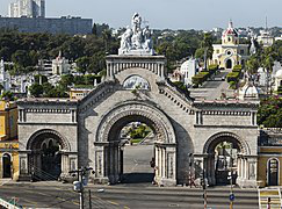
Colon Cemetery

Morro Fortress
6.History and culture
The city of Havana was founded by the Spanish in the 16th century and due to its strategic location it served as a springboard for the Spanish conquest of the Americas, becoming a stopping point for treasure-laden Spanish galleons returning to Spain. The King Philip II of Spain granted Havana the title of City in 1592.Walls as well as forts were built to protect the old city.The sinking of the U.S. battleship Maine in Havana's harbor in 1898 was the immediate cause of the Spanish–American War.
Havana, by far the leading cultural centre of the country, offers a wide variety of features that range from museums, palaces, public squares, avenues, churches, fortresses (including the largest fortified complex in the Americas dating from the 16th through 18th centuries), ballet and from art and musical festivals to exhibitions of technology. The restoration of Old Havana offered a number of new attractions, including a museum to house relics of the Cuban revolution. The government placed special emphasis on cultural activities, many of which are free or involve only a minimal charge.
Old Havana
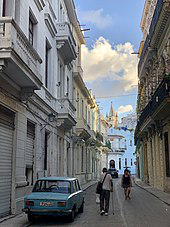
Old Havana from street level
Old Havana, (La Habana Vieja in Spanish), contains the core of the original city of Havana, with more than 2,000 hectares it exhibits almost all the Western architectural styles seen in the New World. La Habana Vieja was founded by the Spanish in 1519 in the natural harbor of the Bay of Havana. It became a stopping point for the treasure laden Spanish Galleons on the crossing between the New World and the Old World. In the 17th century, it was one of the main shipbuilding centers. The city was built in baroque and neoclassic style.
Many buildings have fallen in ruin but a number are being restored. The narrow streets of Old Havana contain many buildings, accounting for perhaps as many as one-third of the approximately 3,000 buildings found in Old Havana.
Old Havana is the ancient city formed from the port, the official center and the Plaza de Armas. Alejo Carpentier called Old Havana the place "de las columnas" (of the columns). The Cuban government is taking many steps to preserve and to restore Old Havana, through the Office of the city historian, directed by Eusebio Leal. Old Havana and its fortifications were added to the UNESCO World Heritage List in 1982. The beauty of Old Havana City attracts millions of tourists each year who enjoy its rich old culture and folk music.
In spring 2015, the largest open-air art exhibition ever in Cuba took in front of the basilica on the Plaza San Francisco de Asis: Over eight weeks the United Buddy Bears visited Havana. United Buddy Bears exhibitions are part of a non-commercial and non-profit project. The main aim is to promote the idea of tolerance and mutual understanding between countries, cultures and religions and to communicate a vision of a future peaceful world.
Barrio Chino
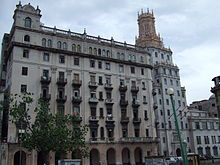
Barrio Chino in Centro Habana
Barrio Chino was once Latin America's largest and most vibrant Chinese community, incorporated into the city by the early part of the 20th century. Hundreds of thousands of Chinese workers were brought in by Spanish settlers from Guangdong, Fujian, Hong Kong, and Macau via Manila, Philippines starting in the mid-19th century to replace or work alongside Africanslaves. After completing 8-year contracts, many Chinese immigrants settled permanently in Havana..
The first 206 Chinese-born arrived in Havana on June 3, 1847.The neighborhood was booming with Chinese restaurants, laundries, banks, pharmacies, theaters and several Chinese-language newspapers, the neighborhood comprised 44 square blocks during its prime.The heart of Barrio Chino is on el Cuchillo de Zanja (or The Zanja Canal). The strip is a pedestrian-only street adorned with many red lanterns, dancing red paper dragons and other Chinese cultural designs, there is a great number of restaurants that serve a full spectrum of Chinese dishes – unfortunately that 'spectrum' is said by many who? not to be related to real Chinese cuisine.
The district has two paifang (Chinese arches), the larger one located on Calle Dragones. Chinadonated the materials in the late 1990s. It has a well defined written welcoming sign in Chineseand Spanish. The smaller arch is located on Zanja strip. The Cuban's Chinese boom ended when Fidel Castro's 1959 revolution seized private businesses, sending tens of thousands of business-minded Chinese fleeing, mainly to the United States. Descendants are now making efforts to preserve and revive the culture.
Visual arts
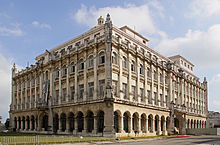
Museo de la Revolución
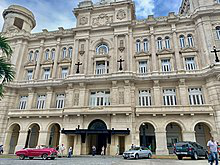
Museo Nacional de Bellas Artes
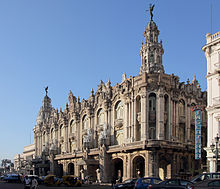
Great Theatre of Havana
The National Museum of Fine Arts (Museo Nacional de Bellas Artes) is a Fine Arts museum that exhibits Cuban and International art collections. The museum houses one of the largest collections of paintings and sculpture from Latin America and is the largest in the Caribbean region Under the Cuban Ministry of Culture, it occupies two locations in the vicinity of Havana's Paseo del Prado, these are the Palace of Fine Arts, devoted to Cuban art and the Palace of the Asturian Center, dedicated to universal art. Its artistic heritage is made up of over 45,000 pieces.
The Museum of the Revolution (Museo de la Revolución), designed in Havana by Cuban architect Carlos Maruri, and the Belgian Paul Belau, who came up with an eclectic design, harmoniously combines Spanish, French and German architectural elements. The museum was the Presidential Palace in the capital; today, its displays and documents outline Cuba's history from the beginning of the neo-colonial period. The building was the site of the Havana Presidential Palace Attack (1957) by the Directorio Revolucionario Estudiantil.
The neo-classical mansion of the Countess of Revilla de Camargo, today it is the Museum of Decorative Arts (Museo de Artes Decorativas), known as the "small French Palace of Havana" built between 1924 and 1927, it was designed in Paris inspired in French Renaissance.The museum has been exhibiting more than 33,000 works dating from the reigns of Louis XV, Louis XVI, and Napoleon III; as well as 16th to 20th century Oriental pieces, among many other treasures.The Museum has ten permanent exhibit halls. Among them are prominent porcelain articles from the factories in Sèvres and Chantilly, France; Meissen, Germany; and Wedgwood, England, as well as Chinese from the Qianlong Emperorperiod and Japanese from the Imari. The furniture comes from Stéphane Boudin, Jean Henri Riesener and several others.
Several museums in Old Havana houses furniture, silverware, pottery, glass and other items from the colonial period. One of these is the Palacio de los Capitanes Generales, where Spanish governors once lived. The Casa de Africa presents another aspect of Cuba's history, it houses a large collection of Afro-Cuban religious artifacts.
Other museums in the city include Casa de los Árabes (House of Arabs) and the Casa de Asia(House of Asia) with Middle and Far Eastern collections. Havana's Museo del Automobil has an impressive collection of vehicles dating back to a 1905 Cadillac.
While most museums of Havana are situated in Old Havana, few of them can also be found in Vedado. In total, Havana has around 50 museums, including the National Museum of Music; the Museum of Dance and Rum; the Cigar Museum; the Napoleonic, Colonial and Oricha Museums; the Museum of Anthropology; the Ernest Hemingway Museum; the José Martí Monument; the Aircraft Museum (Museo del Aire).
There are also museums of Natural Sciences, the city, Archeology, Gold-and-Silverwork, Perfume, Pharmaceuticals, Sports, Numismatics, and Weapons.
Performing arts
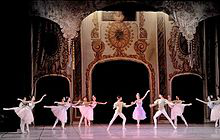
Ballet Nacional de Cuba performing at the Great Theatre
Facing Havana's Central Park is the baroque Great Theatre of Havana, a prominent theatre built in 1837. It is now home of the National Ballet of Cuba and the International Ballet Festival of Havana, one of the oldest in the New World. The façade of the building is adorned with a stone and marble statue. There are also sculptural pieces by Giuseppe Moretti,representing allegories depicting benevolence, education, music and theatre. The principal theatre is the García Lorca Auditorium, with seats for 1,500 and balconies. Glories of its rich history; the Italian tenor Enrico Caruso sang, the Russian ballerina Anna Pavlova danced, and the French Sarah Bernhardt acted.
Other important theatres in the city includes the National Theater of Cuba, housed in a huge modern building located in Plaza de la Revolucion, decorated with works by Cuban artists. The National Theater includes two main theatre stages, the Avellaneda Auditorium and the Covarrubias Auditorium, as well as a smaller theatre workshop space on the ninth floor.
The Karl Marx Theater with its large auditorium have a seating capacity of 5,500 spectators, is generally used for concerts and other events, it is also one of the venues for the annual Havana Film Festival.
7. Other information
Havana is the largest city by area, the most populous city, and the fourth largest metropolitan area in the Caribbeanregion.
The city attracts over a million tourists annually;the Official Census for Havana reports that in 2010 the city was visited by 1,176,627 international tourists, a 20% increase from 2005. Old Havana was declared a UNESCO World Heritage Site in 1982. The city is also noted for its history, culture, architecture and monuments.
8. Contact Information
Address of the municipal government: Gobierno Provincial de La Habana
Tel: 5378682560
Facebook: Gobierno de La Havna
Website: http://www.lahabana.gob.cu
Governor:Reinaldo García Zapata
